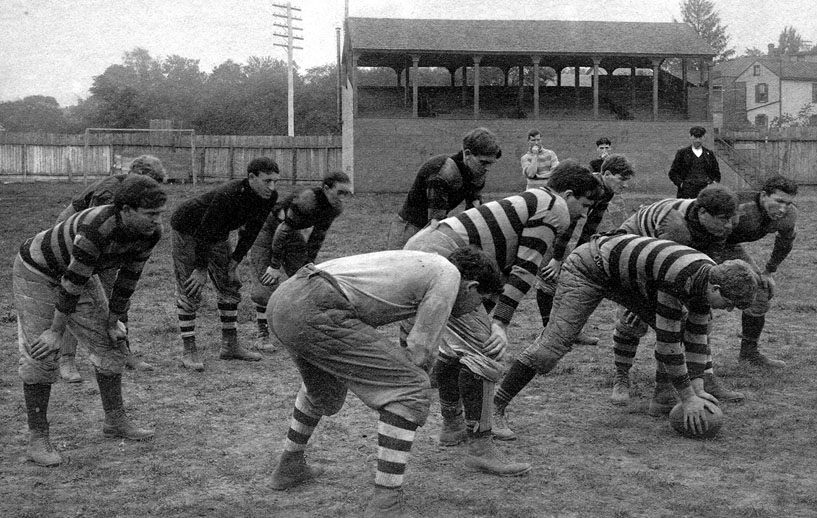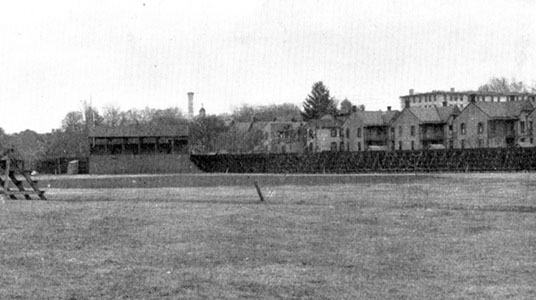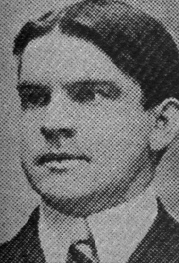
"What's the Snap Count?" -
Athletic Field 1900

"What's the Snap Count?" -
Athletic Field 1900
The 1900 squad shown here marked the move from Dickinson's golden years of football to a period of mediocrity. The coach of the team was Samuel A. Boyle, Jr., a former University of Pennsylvania player, hired for the season.
The generally accepted first season of Dickinson football as an intercollegiate sport was in 1885. The school has records of games before that season but they were not considered seasons, as such. The sport of football at the College got off to a rocky start, but leadership by men like Professor Fletcher Durrell, the "Father of Dickinson Football", helped the sport gain a foothold at the school and grow with the College. Durrell, a Princeton PhD and professor of mathematics and astronomy, was instrumental in organizing contests, players, and even playing himself in a number of games. The colors of the team, Red and White, were chosen in 1887 from the colors of two rival student literary societies, the Union Philosophical and the Belles Lettres. The team up until 1888 had never had a coach and in 1888 the team came under the direction of the Professor of Physical Culture. The following year, the College moved to purchase its first athletic field. Games had previously been held at the Fair Grounds. A new constitution was drafted that increased the powers of the Athletic Association and land was leased northwest of the college. 1889 marked the first winning record for the football team with a 4-1-1 mark. The early seasons of intercollegiate football at Dickinson were marked by controversial games. This was due to the lack of official rules and procedures for the games. As noted above, the year 1890 brought the college its first permanent field located at the corner of Louther and Cherry Streets.
At about the same time that the athletic facilities at Dickinson were improving, the demand arose for the college to hire a full-time coach so that the team would be properly prepared for the competitive season. Previously, only large powerhouses like the University of Pennsylvania, Lehigh, and Lafayette had the financial resources and demand for a head coach. Dickinson wanted to be able to compete with these teams and in 1896 the college hired its first true head coach, on a seasonal basis, in Dr. Nathan P. Stauffer, a University of Pennsylvania graduate. The Athletic Association also enacted new eligibility rules governing the rules under which players could participate in intercollegiate contests only if they were college students taking required numbers of course hours.


Dr.
Nathan P. Stauffer, First Head Coach
Dickinson College, 1896-99

| Left End
O. Nevin Diehl (01)
Left Tackle John A. McGuffie (02)-Law Left Guard Paul A. A. Core (03)-Law Center Edwin C. Ammerman (02) Right Guard J.M. Phillips (03)-Law Right Tackle William Decker (02) Right End John D. Brooks (01) or George W. Pedlow (01) Quarterback Edwin F. Hann (01) Halfback Steward F. Shiffer (01) Halfback Frank J. Cannon (03)-Law Fullback William L. Stanton (03) |
Head Coach:
Samuel A. Boyle, Jr.
Assistant Coach: Forrest E. "Cap" Craver Manager: Charles S. Evans Assistant Manager: James F. Jarrel Captain: George W. Pedlow |

Forrest E. "Cap" Craver, Captain 1897 Head Coach 1904; 1916; 1919-21 Co-Coach 1909 & 1910 |

George W. Pedlow, Captain 1900 |
Dickinson
Opponent
Indians
0
21
Swarthmore
12
0
U. Penn
0
35
Penn State
18
0
Haverford
27
0
Gettysburg
49
0
Syracuse
0
6
Lehigh
0
6
F&M
7
5
Lafayette
10
6
The football program of Dickinson College has come far from its beginnings in the late nineteenth century. The uniforms, equipment, and training facilities have changed much during the nearly 120 years of competitive play. By refering to this page and the 1890 photograph of the Dickinson-F&M game, one can see how the uniforms in a ten year period changed. Also, the idea of formations and the forward pass were coming into being by 1900, whereas a decade earlier the primary formation was "the wedge," a mass rugby-like formation meant to drive through an opposing defense. Formations became more elegant, if the players did not, and football began evolving towards the game of strategy and adaptation that it is today. Notice the players wear no helmets, their only pads consisting of thick pants, shinguards on some, and thick, reinforced rugby type shirts. The photograph of Forrest "Cap" Craver is a good illustration of the uniform of the time. Numbers would not be used for a number of years. Cleats were in use however, the advantage of good traction in possibly bad conditions already having been recognized.
Throughout its existence, the Dickinson College football program has been composed of young men taking the field to battle in a game of strategy and brutality. They fight for victory, for their College, but mainly, they fight for each other.
Timothy Ferguson